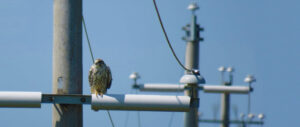Third International Scientific and Practical Conference “Eagles of the Palearctic: Study and Conservation”
Raptors Conservation. Suppl. 2. Proceedings of Conferences
Saving raptors in Mongolia: country-scale retrofitting of insulation to reduce avian electrocution at power lines
Dixon A. (Mohamed Bin Zayed Raptor Conservation Fund, Abu Dhabi, UAE)
Batbayar N., Bold B. (Wildlife Science and Conservation Center, Ulaanbaatar, Mongolia)
Purev-Ochir G., Gunga A. (Mongolian Bird Conservation Center, Ulaanbaatar, Mongolia)
Virani M. (Mohamed Bin Zayed Raptor Conservation Fund, Abu Dhabi, UAE)
Contact:
Andrew Dixon adixonwales@gmail.com
Nayambayar Batbayar nyambayar@wscc.org.mn
Batbayar Bold info@wscc.org.mn
Gankhuyag Purev-Ochir pgankhuyag@gmail.com
Amarkhuu Gunga amarkhuu@mbcc.mn
Munir Virani munir.virani@raptorconservationfund.com
Recommended citation: Dixon A., Batbayar N., Bold B., Purev-Ochir G., Gunga A., Virani M. Saving raptors in Mongolia: country-scale retrofitting of insulation to reduce avian electrocution at power lines. – Raptors Conservation. 2023. S2: 403–405. DOI: 10.19074/1814-8654-2023-2-403-405 URL: http://rrrcn.ru/en/archives/35169
The delivery of electricity to widely dispersed communities across the open steppe grasslands of Mongolia depends on medium-voltage (10–35 kV) distribution lines, often carrying power over substantial distances. Previously utilizing wooden supports, upgraded and new distribution lines are now designed to be cheaper, using steel-reinforced concrete poles with galvanized steel crossarms that can carry an electrical charge to the ground. Consequently, any bird that perches on these poles and simultaneously touches a conducting cable can be electrocuted, which is a significant risk for medium to large-sized birds at 10 kV and 15 kV lines utilizing pin-insulators. Surveys and monitoring of these dangerous power lines revealed that raptor electrocution rates were high, especially in areas with abundant prey, and widespread across steppe habitats. With around 3,500 km of hazardous lines in the Mongolian steppe zone, it was estimated around 18,000 raptors, including 4,000 Saker Falcons (Falco cherrug), were electrocuted each year.
Experimental trials indicated that retrofitting insulation could significantly reduce electrocution risk. However, off-the-shelf mitigation equipment was either not suitable or too expensive to be deployed at scale in Mongolia. Consequently, we designed and manufactured our own equipment to meet our six criteria of being (i) effective, (ii) durable, (iii) failsafe with (iv) no impact on power supply, (v) simple to install and (vi) low cost. This equipment comprises acrylonitrile styrene acrylate (ASA) insulation covers that fit over the crossarms and a concrete pole tops of standard line poles, suitable for retrofitting existing lines and being incorporated into new lines. Over the period 2019–2022, we retrofitted insulation to 34,425 poles at 67 power lines covering a linear distance of 3,450 km, at an equipment cost of less than USD $40 per pole. Comparison of carcass counts under poles before and after retrofitting indicated a significant reduction in electrocution events. To our knowledge, this is the largest single powerline retrofitting project globally, demonstrating that effective mitigation can be deployed at scale, saving tens of thousands of raptors from electrocution for a relatively low cost. We hope to use this project as an exemplar to focus attention and attract funding to address the issue of raptor electrocution at a global scale.

Saker falcon (Falco cherrug) on a power line support with a traverse protected by casing. Photo by E. Dixon.
